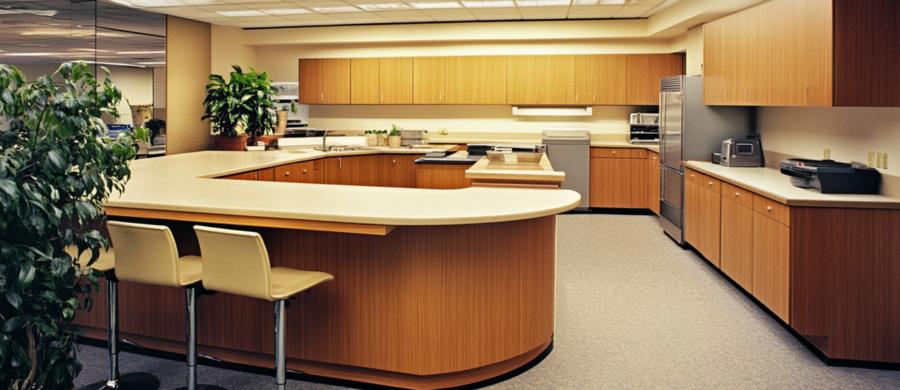Lighting: Less “Interrogation Room,” More “Tranquil Retreat”
If the office kitchen’s fluorescent lights make employees feel like they’re being questioned about a crime they didn’t commit, it’s time for a change. Harsh, overhead lighting isn’t just unflattering—it actively contributes to stress. Studies show that bright, cold-toned lights can increase alertness, but not in a good way. Think “fight-or-flight,” not “ready to seize the day.”Soft, warm lighting is the key to creating a relaxed environment. Swap out those soul-draining tubes for LED fixtures with a dimmable, warmer glow. If your kitchen has windows, embrace natural light as much as possible. It turns out that humans, much like houseplants, thrive when given proper exposure to the sun.
And for a final touch of ambiance, consider under-cabinet lighting. Not only does it prevent accidental late-afternoon coffee spills, but it also gives the kitchen a cozy, café-like atmosphere—minus the overpriced muffins.
Color: Because Beige Is an Emotional Black Hole
The average office kitchen is a shrine to neutral tones, featuring beige walls, gray cabinets, and the occasional “motivational” poster curling at the edges. It’s the aesthetic equivalent of a sigh.Color psychology tells us that certain hues can influence mood, so it makes sense to introduce shades that promote relaxation. Soft blues and greens evoke nature, lowering stress and boosting a sense of well-being. Warm earth tones, like terracotta or muted yellows, create a comforting and inviting atmosphere—like being wrapped in a metaphorical (and, importantly, office-appropriate) hug.
But let’s not go overboard. Neon orange walls might energize a room, but they also make it feel like an off-brand fast-food restaurant. And no one wants their break space to feel like it’s urging them to order a value meal.
Layout: A Space That Welcomes, Not Overwhelms
An office kitchen should be a place of refuge, not an obstacle course. If employees have to dodge rogue chairs, navigate a gauntlet of people loitering by the microwave, or engage in a delicate ballet to get to the coffee machine, stress levels are bound to rise.A good layout focuses on flow. Keep high-traffic areas clear and ensure there’s ample counter space for food prep. If possible, create distinct zones: a coffee station, a snack area, and a seating space that actually encourages people to sit.
Seating should be comfortable, but not “accidentally nap-inducing.” A mix of barstools, cozy benches, and small tables fosters both solitary coffee breaks and impromptu team discussions. And while the dream of a full-fledged nap pod in the kitchen might be unrealistic, a well-placed lounge chair never hurt anyone.
Indoor Plants: Because Oxygen Is Important
Nothing says “stress relief” like a little bit of greenery. Indoor plants don’t just make a space look nicer—they also improve air quality, reduce noise levels, and even boost productivity. Plus, they’re the only coworkers that never microwave fish or leave their dishes in the sink.Low-maintenance plants like pothos, snake plants, and peace lilies thrive indoors and require very little effort. If you really want to commit to the Zen vibe, consider a small indoor herb garden. Not only does it add a refreshing scent to the kitchen, but it also gives employees the joy of pretending they’re gourmet chefs while making instant noodles.
Just avoid anything too high-maintenance. The office doesn’t need another tragic plant funeral when no one remembers to water the fiddle-leaf fig.
Soundproofing: The Only Way to Enjoy a Coffee Break Without Hearing Karen’s Voicemail Rant
An office kitchen should be a break from the noise, not just an extension of the open-plan chaos. Yet, all too often, it becomes an echo chamber of clanking dishes, beeping microwaves, and Greg’s 15-minute summary of the latest true-crime podcast.Soundproofing elements can work wonders for stress relief. Soft materials like cork walls, fabric panels, or even a well-placed rug can absorb noise and make conversations feel less like they’re happening in a train station.
If total soundproofing isn’t an option, white noise machines or a subtle playlist of nature sounds can provide a sense of calm. After all, it’s hard to stay tense when there’s the gentle sound of ocean waves in the background—unless, of course, it makes you want to quit and move to a beach town.
Aromatherapy: Tricking the Brain Into Relaxation
The office kitchen’s scent profile often includes stale coffee, yesterday’s lunch, and an air freshener that’s trying way too hard. But the right scents can actually reduce stress and make the space feel more inviting.Essential oil diffusers (strategically placed away from food prep areas) can subtly infuse the kitchen with calming scents like lavender, chamomile, or eucalyptus. Citrus scents like lemon and bergamot can also boost energy without inducing anxiety.
However, there’s a fine line between “refreshing” and “overpowering.” If people walk in and immediately feel like they’ve been drop-kicked into a lavender field, you might need to dial it back.
A Zen Ending: Less Stress, More Snacks
Office kitchens don’t have to be chaotic, stress-inducing spaces where people rush in and out like they’re on a mission. With the right design choices, they can become small sanctuaries—places where employees can take a moment to breathe, recharge, and maybe even enjoy a snack without feeling like they’re competing in an unspoken survival game.By focusing on calming lighting, thoughtful color choices, smart layouts, greenery, soundproofing, and subtle aromatherapy, an office kitchen can go from just another break room to a true escape from the daily grind. And if all else fails? At least make sure the coffee is strong, the fridge isn’t a biohazard, and Steve stops microwaving fish.
Article kindly provided by kitchenrenovationlondon.co.uk

